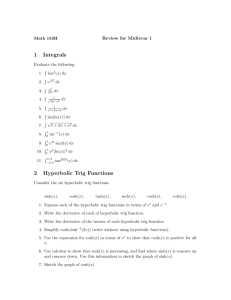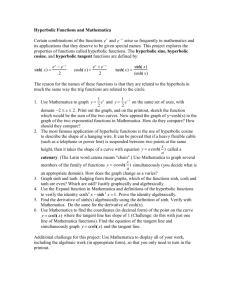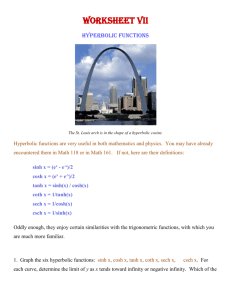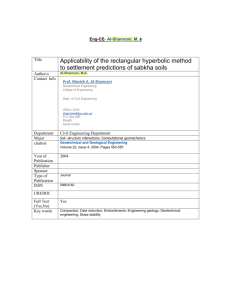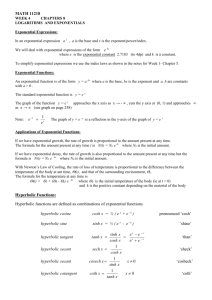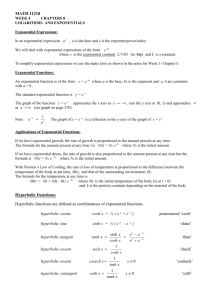Standard algebraic expressions
advertisement
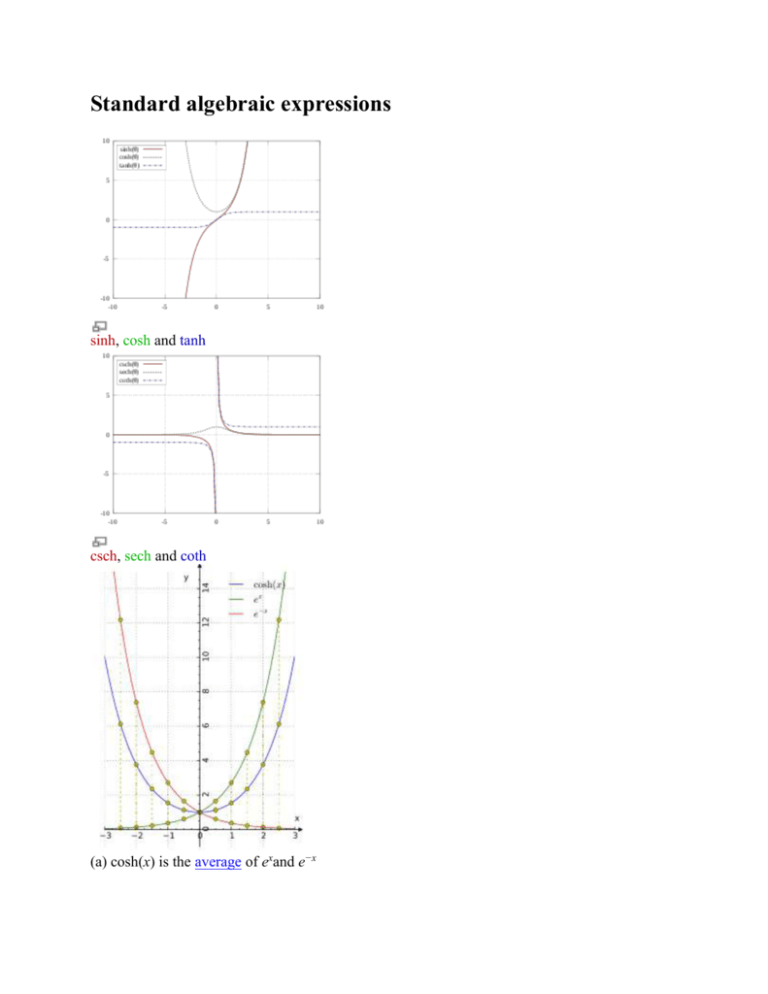
Standard algebraic expressions
sinh, cosh and tanh
csch, sech and coth
(a) cosh(x) is the average of exand e−x
(b) sinh(x) is half the difference of ex and e−x
Hyperbolic functions (a) cosh and (b) sinh obtained using exponential functions
The hyperbolic functions are:
Hyperbolic sine:
Hyperbolic cosine:
Hyperbolic tangent:
Hyperbolic cotangent:
and
Hyperbolic secant:
Hyperbolic cosecant:
Hyperbolic functions can be introduced via imaginary circular angles:
Hyperbolic sine:
Hyperbolic cosine:
Hyperbolic tangent:
Hyperbolic cotangent:
Hyperbolic secant:
Hyperbolic cosecant:
where i is the imaginary unit defined by i2 = −1.
The complex forms in the definitions above derive from Euler's formula.
Note that, by convention, sinh2 x means (sinh x)2, not sinh(sinh x), and similarly for the other
hyperbolic functions when used with positive exponents. In contrast, sinh-1 x refers to the inverse
function arsinh x and not to a reciprocal (and again likewise for the other hyperbolic functions).
Useful relations
Hence:
It can be seen that cosh x and sech x are even functions; the others are odd functions.
Hyperbolic sine and cosine satisfy the identity
which is similar to the Pythagorean trigonometric identity. One also has
for the other functions.
The hyperbolic tangent is the solution to the nonlinear boundary value problem[5]:
It can be shown that the area under the curve of cosh x is always equal to the arc length:[6]
Sums of arguments:
Sum and difference of cosh and sinh:
Inverse functions as logarithms
Derivatives
Standard Integrals
For a full list of integrals of hyperbolic functions, see list of integrals of hyperbolic functions
Where C is the constant of integration.
Taylor series expressions
It is possible to express the above functions as Taylor series:
The function sinh x has a Taylor series expression with only odd exponents for x. Thus it is an
odd function, that is, −sinh x = sinh(−x), and sinh 0 = 0.
The function cosh x has a Taylor series expression with only even exponents for x. Thus it is an
even function, that is, symmetric with respect to the y-axis. The sum of the sinh and cosh series
is the infinite series expression of the exponential function.
(Laurent series)
(Laurent series)
where
is the nth Bernoulli number
is the nth Euler number
Comparison with circular trigonometric functions
Consider these two subsets of the Cartesian plane
Then A forms the right branch of the unit hyperbola {(x,y): x2 − y2 = 1}, while B is the unit circle.
Evidently
= {(1,0)}. The primary difference is that the map t → B is a periodic function
while t → A is not.
There is a close analogy of A with B through split-complex numbers in comparison with ordinary
complex numbers, and its circle group.[clarification needed] In particular, the maps t → A and t → B
are the exponential map in each case. They are both instances of one-parameter groups in Lie
theory where all groups evolve out of the identity
For contrast, in the
terminology of topological groups, B forms a compact group while A is non-compact since it is
unbounded.
The hyperbolic functions satisfy many identities, all of them similar in form to the trigonometric
identities. In fact, Osborn's rule[7] states that one can convert any trigonometric identity into a
hyperbolic identity by expanding it completely in terms of integral powers of sines and cosines,
changing sine to sinh and cosine to cosh, and switching the sign of every term which contains a
product of 2, 6, 10, 14, ... sinhs. This yields for example the addition theorems
the "double argument formulas"
and the "half-argument formulas"[8]
Note: This is equivalent to its circular counterpart
multiplied by −1.
Note: This corresponds to its circular counterpart.
The derivative of sinh x is cosh x and the derivative of cosh x is sinh x; this is similar to
trigonometric functions, albeit the sign is different (i.e., the derivative of cos x is −sin x).
The Gudermannian function gives a direct relationship between the circular functions and the
hyperbolic ones that does not involve complex numbers.
The graph of the function a cosh(x/a) is the catenary, the curve formed by a uniform flexible
chain hanging freely between two fixed points under uniform gravity.
Relationship to the exponential function
From the definitions of the hyperbolic sine and cosine, we can derive the following identities:
and
These expressions are analogous to the expressions for sine and cosine, based on Euler's formula,
as sums of complex exponentials.
Hyperbolic functions for complex numbers
Since the exponential function can be defined for any complex argument, we can extend the
definitions of the hyperbolic functions also to complex arguments. The functions sinh z and
cosh z are then holomorphic.
Relationships to ordinary trigonometric functions are given by Euler's formula for complex
numbers:
so:
Thus, hyperbolic functions are periodic with respect to the imaginary component, with period
(
for hyperbolic tangent and cotangent).
Hyperbolic functions in the complex plane
See also

